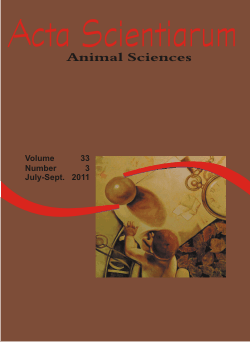<b>Produção anual e qualidade de pastagem de <em>Brachiaria decumbens</em> diferida e estratégias de adubação nitrogenada</b> - doi: 10.4025/actascianimsci.v33i3.10194
Resumo
O objetivo deste trabalho foi avaliar a produção de Brachiaria decumbens diferidos por períodos de 95 e 140 dias. Foram realizados dois ensaios experimentais (95 e 140 dias) e em cada ensaio foram estudadas quatro estratégias de adubação no início e no final do verão (0-0, 100-0, 50-50, 0-100 kg há-1 de N), respectivamente, com quatro repetições. A maior (p < 0,05) produção anual de matéria seca (MS) foi verificada para a estratégia de adubação com 100 kg ha-1 de N aplicados no início do verão (100-0), nos pastos diferidos com 95 dias. Entretanto, no outono, inverno e primavera, a estratégia de aplicação de 100 kg ha-1 de N no final do verão (0-100), proporcionou maiores (p < 0,05) produções de forragem. A produção diária de matéria seca, quando comparada ao verão, sofreu reduções de 8, 89 e 58% para as estações outono, inverno e primavera, respectivamente, no ensaio de 95 dias de diferimento. Pode-se inferir que a estratégia de aplicação de 100 kg ha-1 no final do verão é uma estratégia adequada para aumentar a produção de matéria seca para os pastos avaliados nos dois períodos de diferimento estudados, reduzindo a curva de sazonalidade da produção anual de forragem.Downloads
DECLARAÇÃO DE ORIGINALIDADE E DIREITOS AUTORAIS
Declaro que o presente artigo é original, não tendo sido submetido à publicação em qualquer outro periódico nacional ou internacional, quer seja em parte ou em sua totalidade.
Os direitos autorais pertencem exclusivamente aos autores. Os direitos de licenciamento utilizados pelo periódico é a licença Creative Commons Attribution 4.0 (CC BY 4.0): são permitidos o compartilhamento (cópia e distribuição do material em qualqer meio ou formato) e adaptação (remix, transformação e criação de material a partir do conteúdo assim licenciado para quaisquer fins, inclusive comerciais.
Recomenda-se a leitura desse link para maiores informações sobre o tema: fornecimento de créditos e referências de forma correta, entre outros detalhes cruciais para uso adequado do material licenciado.








































